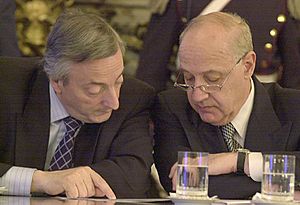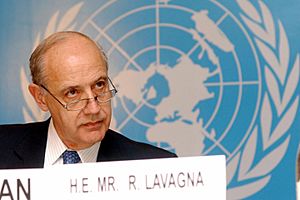Roberto Lavagna facts for kids
Quick facts for kids
Roberto Lavagna
|
|
|---|---|

Lavagna in 2019
|
|
| Minister of Economy | |
| In office 27 April 2002 – 28 November 2005 |
|
| President | Eduardo Duhalde (2002–03) Néstor Kirchner (2003–05) |
| Preceded by | Jorge Remes Lenicov |
| Succeeded by | Felisa Miceli |
| Argentine Ambassador to the European Union | |
| In office 1 August 2000 – 27 April 2002 |
|
| President | Fernando de la Rúa (2000–01) Eduardo Duhalde (2002) |
| Preceded by | Jorge Remes Lenicov |
| Personal details | |
| Born | 24 March 1942 Buenos Aires, Argentina |
| Political party | Independent (2007–2013, 2019–present) |
| Other political affiliations |
Justicialist Party (1973–2007) Renewal Front (2013–2019) Federal Consensus (2019–2023) Hacemos por Nuestro País (since 2023) |
| Spouse |
Claudine Marechal
(m. 1970) |
| Children | Sergio, Marco and Nicolás |
| Alma mater | University of Buenos Aires |
| Profession | |
Roberto Lavagna, born on March 24, 1942, is an Argentine economist and politician. He served as the Minister of Economy and Production for Argentina from April 2002 to November 2005. He is known for his work in helping Argentina's economy recover during a difficult time.
In the 2019 presidential election, he received about 6% of the votes. He has worked to build alliances with parties like the Socialist Party. This was to support the Federal Consensus in the legislative elections of 2021 and increase its presence in the Congress.
Contents
About Roberto Lavagna
Early Life and Education
Roberto Lavagna was born in 1942 in the Saavedra area of Buenos Aires, Argentina. His father owned a printing shop. A few years later, his family moved to Morón, a suburb west of Buenos Aires.
Lavagna studied at the University of Buenos Aires. He graduated in 1967 with a degree in political economy. After that, he received a scholarship to study in Belgium. There, he earned a graduate degree in econometrics and economic policy. In Belgium, he met Claudine Marechal, a student from Belgium. They married in 1970 and have three children together. Lavagna also has an honorary doctorate from the University of Concepción del Uruguay.
Starting His Career
In 1973, after Héctor Cámpora became President, Lavagna began working in public service. He was named the National Director of Price Policy. Soon after, he became the Director of Incomes Policy under the Economy Minister, José Ber Gelbard. In this role, he helped manage a plan called the "Social Pact." This plan aimed to control inflation while also increasing wages for workers.
After Gelbard resigned in 1974, Lavagna moved to the private sector. He joined the board of directors of La Cantábrica, a steel company in Morón. He also helped start Ecolatina in 1975, which is a group that studies economic issues. From 1980 to 1990, he was also on the board of the Institute for Applied Economics and Society (IdEAS).
Lavagna returned to public service from 1985 to 1987. He served as Secretary of Industry and Foreign Commerce under President Raúl Alfonsín. During this time, he helped negotiate early trade agreements with Brazil. These agreements later led to the creation of the Mercosur trade region in 1991. In 2000, he left Ecolatina to become an Ambassador-at-large. This role involved representing Argentina at international economic meetings and with the European Union.
Minister of Economy Role

On April 27, 2002, Roberto Lavagna was appointed Minister of Economy by interim President Eduardo Duhalde. He took on this important role during a very difficult time for Argentina, known as the Argentine economic crisis.
One of his first big challenges was to end the corralito. This was a rule that limited how much money people could take out of their bank accounts. He also worked to stabilize the Argentine peso, which had lost a lot of its value. The peso became more stable, and Argentina's economy started to recover strongly.
When Néstor Kirchner became President in May 2003, Lavagna continued in his role. He gained more praise for how he handled Argentina's debt. In 2005, he launched a plan to reorganize Argentina's public debt. This plan helped reduce the amount of money Argentina owed and allowed the country to recover financially.
Despite these successes, President Kirchner removed Lavagna from his position on November 28, 2005. He was replaced by Felisa Miceli. The exact reasons for his removal were not made public. However, it was thought that there were disagreements between Lavagna and President Kirchner. Lavagna himself said that the President wanted to make changes to his team after the elections.
After His Time as Minister

After leaving his role as Minister, Lavagna decided to run for president. He formed a group called UNA, which stands for "Una Nacion Avanzada" ("An Advanced Nation"). He ran against the government's candidate, Cristina Fernández de Kirchner, in the October 2007 presidential elections.
Many members from other political parties, like the Radical Civic Union (UCR) and the Socialists, supported Lavagna. This was a big deal because it was the first time since 1892 that the UCR supported a candidate from another group instead of their own. Gerardo Morales, the leader of the UCR, became Lavagna's running mate. Lavagna and UNA came in third place, receiving over 3 million votes, which was about 17% of the total. They won only in Córdoba Province.
After the 2007 election, Lavagna had discussions with Néstor Kirchner about the future of the Justicialist Party (PJ). It was thought that Lavagna might become a vice-president of the party. However, he later decided not to take a position on the PJ executive. Lavagna eventually became an opponent of President Fernández de Kirchner. In 2013, he helped create a group called Unidos Para Cambiar ('United for Change'). This group included other important opponents of Kirchnerism within the PJ.
More Information
- Economy of Argentina
- Argentine debt restructuring
See also
 In Spanish: Roberto Lavagna para niños
In Spanish: Roberto Lavagna para niños

